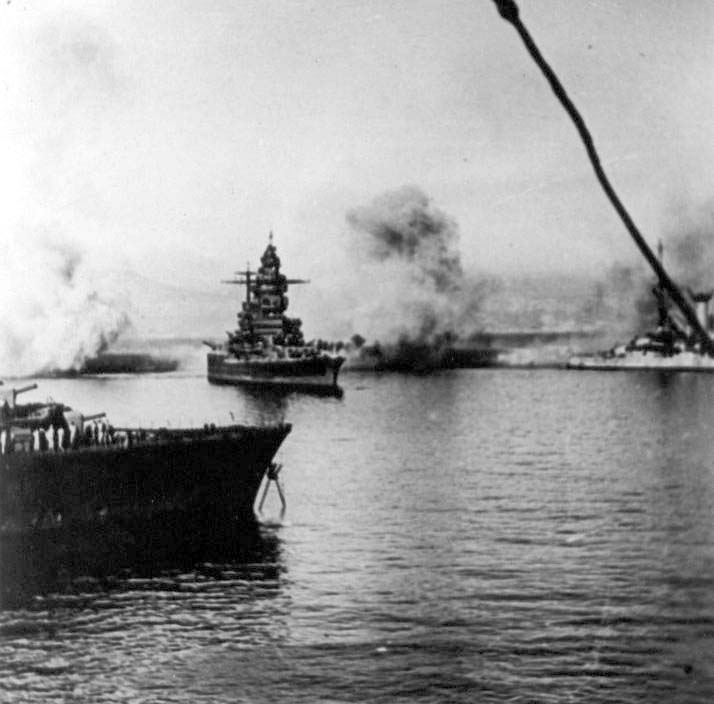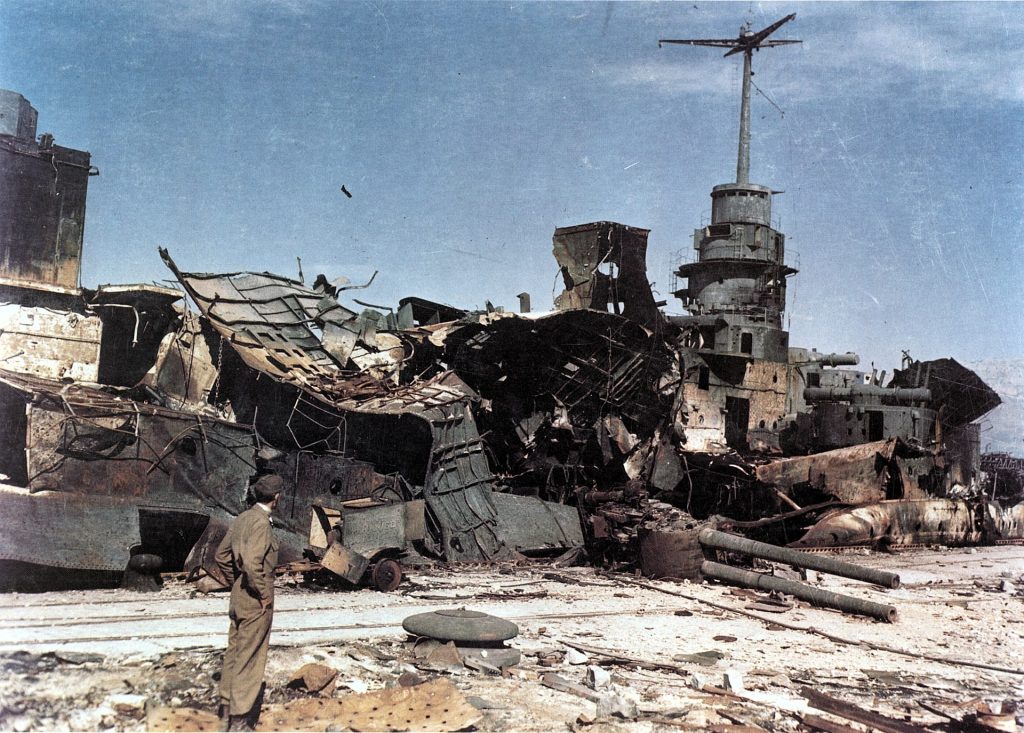The French battleship “Dunkerque” was a groundbreaking naval vessel, launched in 1935, known for its innovative design that blended speed, armor, and firepower.

It played a significant role in the early years of World War II, notably in the Battle of Mers-el-Kébir in 1940, where it was heavily damaged by the British Royal Navy.
Ultimately, “Dunkerque” met its end in 1942 at the naval base of Toulon, where it was scuttled by its crew to prevent capture by advancing German forces.
Historical Context
In the aftermath of World War I, the world’s major naval powers were keen to avoid an arms race similar to the one that had contributed to the outbreak of the war.
This led to the Washington Naval Treaty of 1922 and the subsequent London Naval Treaty of 1930. These treaties aimed to limit the size and armament of battleships and to impose restrictions on new battleship construction.
Nations like France were bound by these treaties, which dictated not only the tonnage but also the firepower of their new battleships.
The “Dunkerque” was designed to comply with these restrictions, specifically targeting a balance between armament, armor, and displacement.
A critical factor driving the development of “Dunkerque” was the expansion and modernization of the Italian Navy.
In the 1930s, Italy began constructing the “Littorio” class battleships, which presented a direct threat to French naval interests in the Mediterranean.
France, already concerned about its historical rival Germany, now faced a two-front naval challenge.
The “Dunkerque” was envisioned as a counter to the Italian threat, designed to match or exceed the capabilities of the Italian battleships while adhering to treaty limitations.
Strategically, France needed a modern and powerful navy to project power and defend its vast colonial empire, which included territories in Africa, Asia, and the Pacific.
The French Navy had to be capable of operating in multiple theaters, requiring ships that were not only powerful but also versatile and capable of long-range operations.
The “Dunkerque” class was designed with these considerations in mind, offering a combination of speed, range, and firepower.
The Design Of Dunkerque
“Dunkerque” featured a unique armament layout. Her main battery consisted of eight 330mm/50 Modèle 1931 guns, arranged in two quadruple turrets located forward of the superstructure.
This configuration, known as “all-forward” armament, was chosen to minimize the length of the armored citadel and to ensure that all main guns could fire directly ahead, maximizing firepower in a chase situation.
This arrangement was a departure from traditional battleship designs, where main guns were typically distributed in turrets both forward and aft.
In addition to her main guns, “Dunkerque” had a formidable secondary and anti-aircraft armament. She carried sixteen 130mm dual-purpose guns, which could be used against both surface and aerial targets.
For close-range anti-aircraft defense, “Dunkerque” was equipped with a range of smaller-caliber guns and, later in her career, with automatic anti-aircraft cannons.
This reflected the growing importance of air power in naval warfare.
The armor scheme of “Dunkerque” was carefully designed to protect against both shellfire and underwater threats, such as torpedoes.
She featured a main armor belt of significant thickness, inclined to increase its effectiveness.
The armor was concentrated over vital areas like ammunition magazines and machinery spaces, employing an “all or nothing” principle.
 Dunkerque pictured in November, 1942.
Dunkerque pictured in November, 1942.
The deck armor was also substantial, designed to fend off plunging fire and aerial bombs. Moreover, “Dunkerque” had a torpedo protection system, consisting of a layered defense with void spaces and liquid-loaded compartments to absorb the shock of underwater explosions.
One of the most remarkable features of “Dunkerque” was her speed. Powered by six Indret boilers and four Rateau-Bretagne geared steam turbines, she was capable of reaching speeds of up to 29.5 knots. This made her one of the fastest battleships of her time.
High speed was a crucial aspect of her design, allowing her to outrun heavier ships and to position herself advantageously in battle. The propulsion system was also designed for efficiency and reliability, important for long-range operations inherent to French naval strategy.
“Dunkerque” included several other innovative design features. She had a compact superstructure to reduce target size and improve stability.
The use of welding in her construction, instead of traditional riveting, saved weight and contributed to her high speed.
Her hull form was also optimized for speed and seakeeping.
Additionally, “Dunkerque” was equipped with advanced fire-control systems for her main and secondary armaments, enhancing her combat effectiveness.
Operational History
“Dunkerque” was commissioned in the mid-1930s, entering into a period of intense naval rivalry and rearmament in Europe.
In the years leading up to World War II, she primarily served in the Atlantic and the Mediterranean, showcasing French naval power and acting as a deterrent against potential adversaries, especially the Italian Navy.
With the outbreak of World War II in 1939, “Dunkerque” and her sister ship “Strasbourg” became integral parts of the French Navy’s efforts to counter Axis naval forces.
During this period, she was involved in several patrols and escort missions, though she did not engage in any major battles against the German Kriegsmarine.
The most notable event in “Dunkerque’s” operational history occurred at Mers-el-Kébir, a port in Algeria.
Following France’s armistice with Germany in June 1940, the British feared that the French fleet, including “Dunkerque,” would be seized by the Germans and used against them.
This led to Operation Catapult, a controversial British action aimed at neutralizing the French fleet.
On July 3, 1940, the British Royal Navy attacked the French ships at Mers-el-Kébir.
“Dunkerque” was heavily damaged by gunfire and had to be beached to prevent sinking.
 Dunkerque under fire during Operation Catapult.
Dunkerque under fire during Operation Catapult.
The Scuttling Of Dunkerque
As part of Operation Torch, the Allied invasion of North Africa, there was a concern that the Germans would try to seize the French fleet stationed at Toulon.
The Vichy French government, which collaborated with Nazi Germany, had promised to keep their ships out of German hands, and the French naval commanders at Toulon were determined to honor this commitment.
When German forces moved to take control of Toulon and seize the fleet, the French Navy, under the orders of Admiral Jean de Laborde, scuttled their ships on November 27, 1942.
This act was to prevent the powerful warships from being used by the Axis powers.
The “Dunkerque” was among the vessels scuttled. The ship was already damaged from previous engagements and was not fully operational at the time.
Her crew opened seacocks and set explosive charges, causing the ship to sink in the harbor.
This scuttling was a significant event, as it effectively ended the operational use of the French fleet during World War II and was a dramatic example of a navy choosing to destroy its ships rather than let them fall into enemy hands.
Aftermath
After the end of World War II, “Dunkerque” was in a state that made her return to active service impractical.
The advent of new naval technologies and warfare tactics had rendered battleships less critical.
 Dunkerque pictured by the Allies when they arrived in Toulon.
Dunkerque pictured by the Allies when they arrived in Toulon.
Moreover, the financial and material costs of restoring a heavily damaged warship from the interwar period were hard to justify in the post-war context.
Recognizing these realities, the French Navy eventually decided to decommission “Dunkerque.” She was stricken from the naval register in the late 1940s.
The decision to scrap “Dunkerque” was a part of a broader trend of phasing out older battleships in favor of more modern and versatile naval vessels.
The scrapping process began in the early 1950s and was completed by the late 1950s, marking the end of the vessel’s journey.